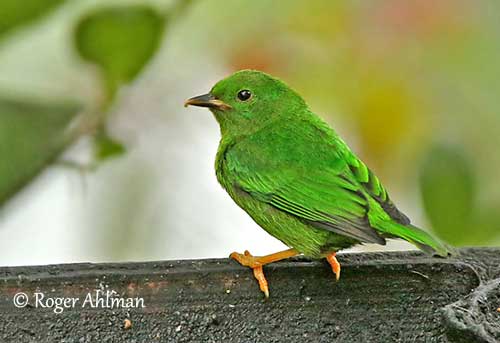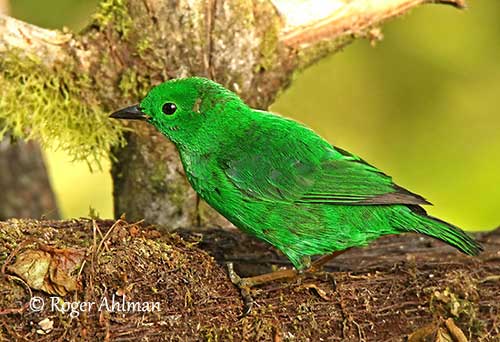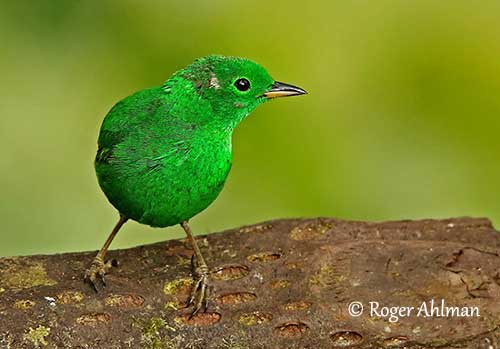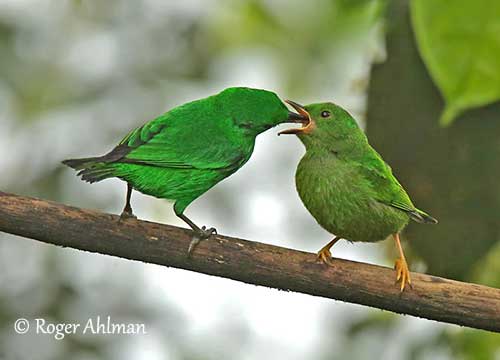
PROTECTION / THREATS / STATUS:
The Glistening-green Tanager has restricted range in which it is uncommon. The species occurs in a narrow band of wet forest on W slope of Andes in Colombia and Ecuador. This area is heavily threatened by deforestation, mining, farming operations and increasing expansion of human population.
The population is suspected to be declining due to ongoing destruction of the habitat. But currently, the Glistening-green Tanager is still evaluated as least Concern.
Fr: Calliste étincelant
Ang: Glistening-green Tanager
All: Rotohr-Bunttangare
Esp: Tangara Verde
Ita: Tanagra verdebrillante
Nd: Zilver-groene Tangare
Sd: grönskimmertangara
Photographer:
Roger Ahlman
Pbase Galleries Peru and Ecuador & My bird pictures on IBC
Text by Nicole Bouglouan
Sources:
HANDBOOK OF THE BIRDS OF THE WORLD Vol 16 by Josep del Hoyo- Andrew Elliot-David Christie – Lynx Edicions – ISBN: 9788496553781
A GUIDE TO THE BIRDS OF COLOMBIA by Steven L. Hilty and William L. Brown - Princeton University Press – ISBN 069108372X
BIRDS OF SOUTH AMERICA – Passerines - by Robert S. Ridgely and Guy Tudor – HELM Field Guides – ISBN: 9781408113424
Birds of Western Ecuador: A Photographic Guide Par Nick Athanas, Paul J. Greenfield – Editeur: Princeton University Press, 2016 – ISBN: 140088070X, 9781400880706
Neotropical Birds – Cornell Lab of Ornithology
CREAGUS@Monterey Bay (Don Roberson)
Fatbirder - Thraupidae - Tanagers & Allies
Glistening-green Tanager
Chlorochrysa phoenicotis
Passeriformes Order – Thraupidae Family
INTRODUCTION:
The Glistening-green Tanager is a beautiful bright green tanager. It is uncommon in the wet mossy forest and tall second growth of Colombia and Ecuador. It feeds on small arthropods and larvae, and takes some fruits too, although being less frugivorous than most tanagers.
The Glistening-green Tanager has restricted range in which it is affected by deforestation and increasing human population. But the species is not currently globally threatened.
DESCRIPTION OF THE BIRD:
Biometrics:
Length: 13 cm
Weight: 20-24 g
The Glistening-green Tanager adult is almost entirely glistening emerald green. On the upperparts, the back is slightly darker whereas the rump is paler. On the upperwings, lesser and median coverts are greyish-olive but often concealed. The black greater coverts show broad bright green edges and tips on the outer webs. The flight-feathers are blackish with bright green edges. The tail is blackish with greenish central pair, but all rectrices have bright green edges.

On the green head, we can see a small tuft of greyish-olive feathers behind the eye, followed by a second one, more conspicuous, of bright orange feathers.
The bill is black. The eyes are dark brown. The strong legs and feet are blackish-grey and well-adapted to the foraging behaviour of this bird.
The female resembles male but she is duller overall.
The juvenile is dull green and lacks the facial markings. Legs and feet are orange, like the gape.

RANGE:
The Glistening-green Tanager is found in Colombia on W slope of the Andes (Antioquia) and Pacific slope of W Andes, S to Ecuador (Pichincha and El Oro).
HABITAT:
The Glistening-green Tanager frequents the upper understorey to subcanopy of the wet mossy forest, forest edges and tall second growth. The species occurs between 700 and 2,200 metres of elevation in Colombia, but mostly above 1,000 metres. In Ecuador, it is found between 600 and 1,700 metres, sometimes up to 2,000 metres of elevation.
CALLS AND SONGS: SOUNDS BY XENO-CANTO
The Glistening-green Tanager most common call is a high, lisping sound of 3-4 notes “czee,czee,czee” or “ee-see-seez-seez” usually weak but distinctive. It also gives series of high-pitched, melodious whistles “tsit-seeseeseesee”.
In Ecuador, the song is more prolonged with slower last notes. A very rapid series of ticking notes may sometimes follow this song.

BEHAVIOUR IN THE WILD:
The Glistening-green Tanager is similar in behaviour to Tangara species, although if feeds more on insects than fruit.
It forages by gleaning actively in outer foliage, moving fast while running along branches or clinging upside down to reach the outermost leaves. It may also leap to catch a prey from the underside of the foliage. It forages from the higher part of the understorey to the crown of small trees. It visits less often fruiting trees than other tanagers.
The Glistening-green Tanager is usually alone or in pairs, and occasionally in family groups. They often join mixed-species flocks.
The breeding behaviour is poorly known. The bright coloured plumage is probably enhanced by adapted postures during the displays that may involve bowing and tail lifting.
The Glistening-green Tanager is apparently resident.
It is a good flier and performs short flights while foraging from tree to tree.

REPRODUCTION OF THIS SPECIES:
The breeding season takes place between May and September in Colombia. In the mountains of both Colombia and Ecuador, the peak occurs in March-April and October-November, when the food resources are abundant.
The breeding system is almost universally monogamous, as several observations suggest that monogamy is the norm in the family Thraupidae.
From an observation, the nest is a small cup hollowed in the moss on side of limb. This one was at medium height.
The young are fed by parents.
No more information.
